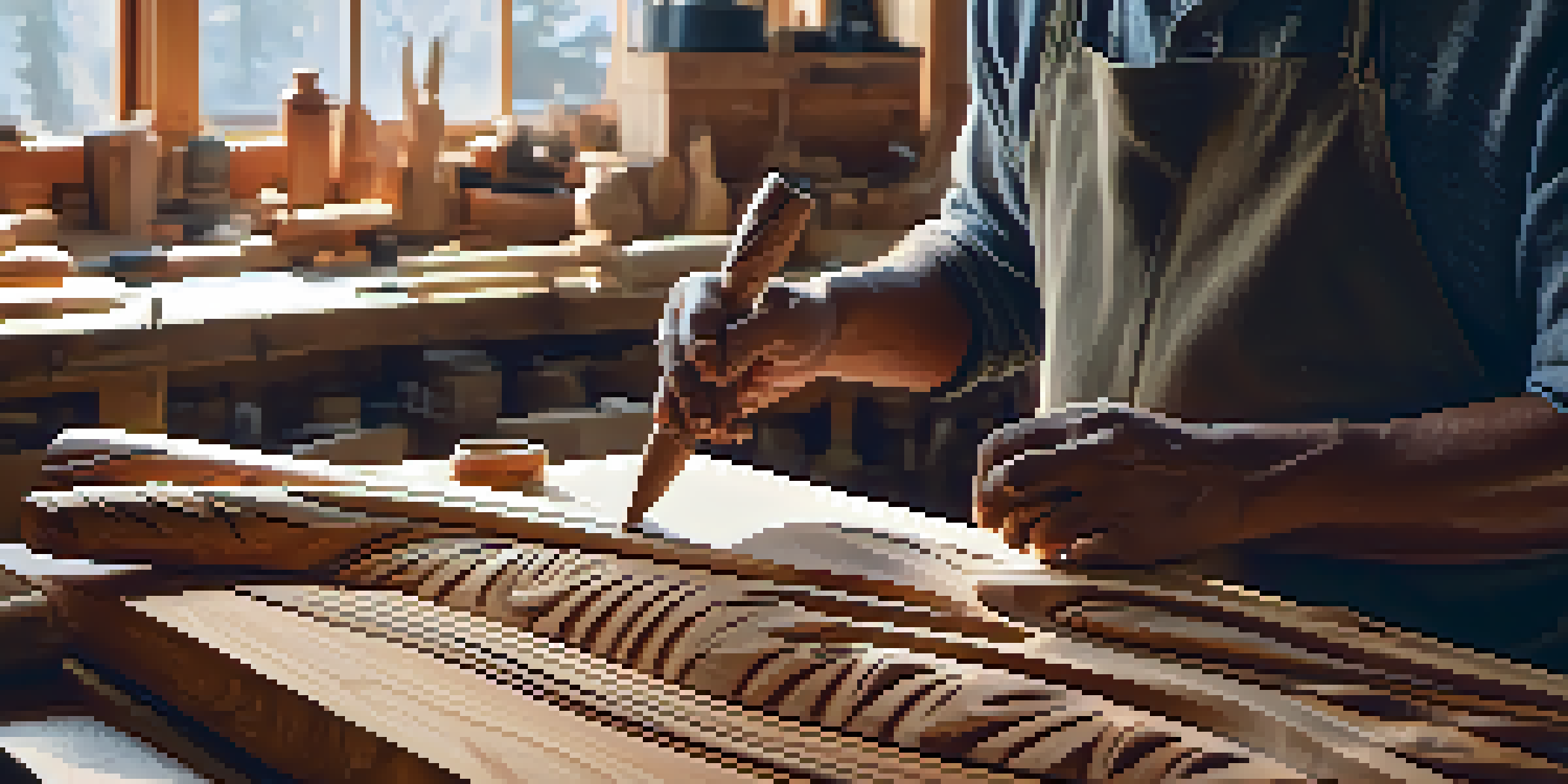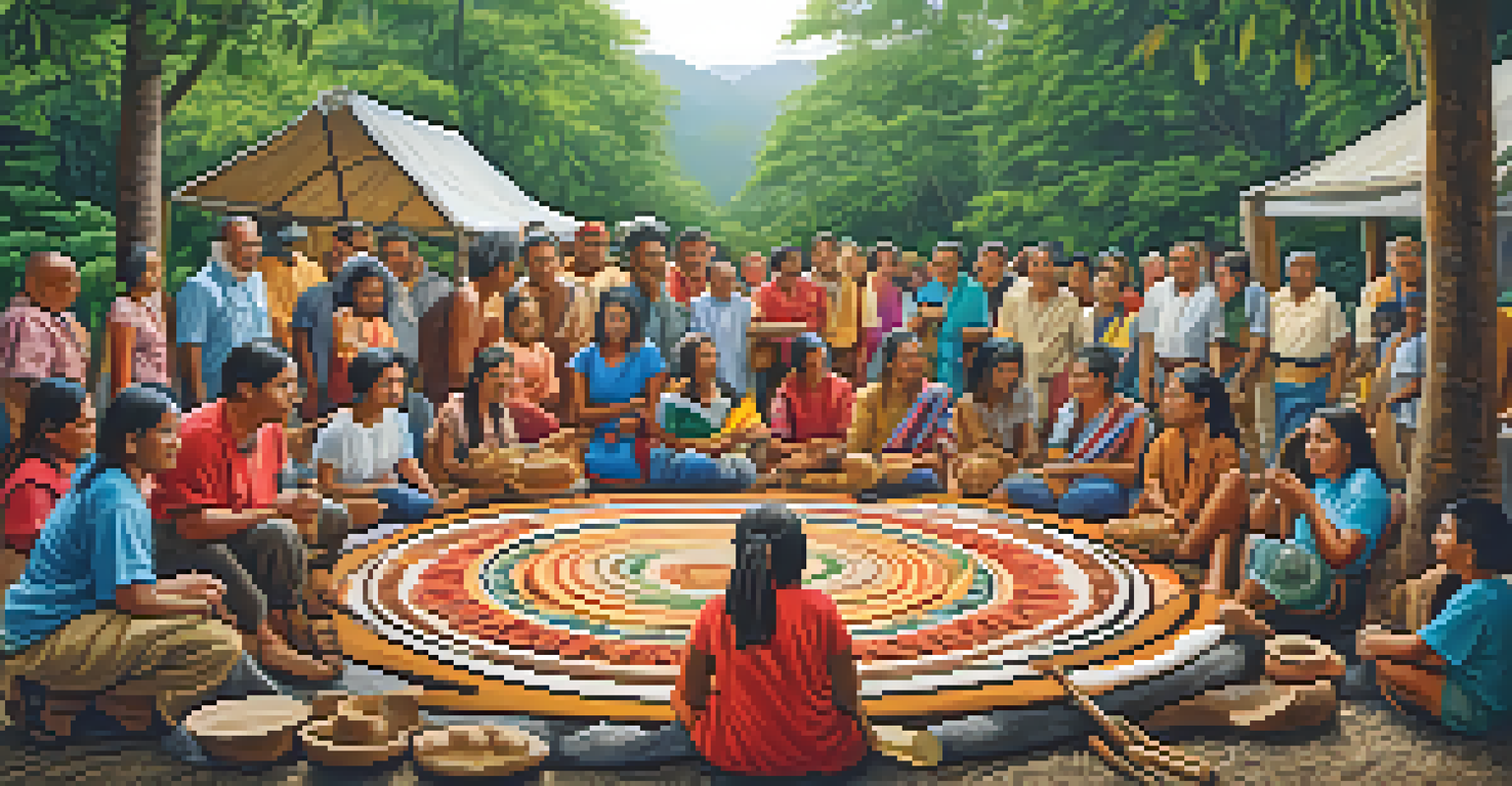Carving in Indigenous Art: Beyond Aesthetic Value

The Cultural Significance of Indigenous Carving
Indigenous carving is not just an art form; it’s a profound expression of cultural identity. Each piece tells stories that connect the artists to their ancestors and community. For many Indigenous cultures, these carvings serve as a bridge between the past and present, preserving traditions and narratives that might otherwise be lost.
Art is the most beautiful of all lies; it is a lie that reveals the truth of our existence.
In many ways, these carvings embody the values, beliefs, and histories of the people who create them. For instance, a totem pole can represent clan lineage, spirits, and significant events in the community's history. Thus, each carving becomes a living record of cultural heritage.
Moreover, the act of carving itself is often intertwined with spiritual practices, where artists seek guidance from their ancestors. This connection to spirituality reinforces the idea that Indigenous art is not merely decorative; it holds deep meaning and significance.
Materials and Techniques in Indigenous Carving
Indigenous artists utilize a variety of materials, each chosen for its cultural relevance and symbolism. Wood, stone, and bone are common, with certain species being favored for their durability and aesthetic qualities. For example, cedar is often used in Pacific Northwest carving due to its lightweight nature and resistance to decay.

The techniques employed also reflect the unique traditions of different Indigenous groups. While some cultures may focus on intricate detailing, others might prioritize bold shapes and forms. This diversity in style showcases the rich tapestry of Indigenous artistry across various regions.
Carving as Cultural Identity
Indigenous carvings serve as profound expressions of cultural identity, connecting artists to their ancestors and community through storytelling.
Additionally, the tools used in carving can be deeply symbolic, often handcrafted from natural materials. This not only reflects the artist’s skill but also their connection to the land and their heritage, emphasizing the importance of environmentally sustainable practices in Indigenous art.
Storytelling Through Carving: A Visual Narrative
At the heart of Indigenous carving lies storytelling, where each piece serves as a visual narrative. Carvings often depict mythological figures, animals, and ancestral stories, creating a dialogue between the viewer and the artwork. This storytelling aspect invites observers to engage with the culture on a deeper level.
The role of art is to make a difference, to change the way we see the world, and to help us understand our own identity.
For instance, a carving of a raven might illustrate a significant creation story, inviting the audience to reflect on its meaning. When viewed in this light, the carving transforms from a mere object into a vessel of knowledge and tradition.
This narrative quality makes Indigenous carvings powerful educational tools, revealing insights into cultural values and worldviews. As such, they play a crucial role in fostering understanding and appreciation of Indigenous histories among broader audiences.
The Role of Carving in Community Identity
Indigenous carvings are vital in reinforcing community identity and cohesion. They serve as symbols of pride and resilience, reminding community members of their shared heritage and values. In many cases, communal carving projects bring people together, fostering collaboration and reinforcing social bonds.
For example, carving events or workshops can become communal gatherings where knowledge and skills are passed down through generations. This process not only strengthens community ties but also ensures that traditional techniques and stories continue to thrive.
Challenges in Indigenous Carving
Modern issues such as cultural appropriation and the loss of traditional knowledge threaten the integrity and continuity of Indigenous carving practices.
The presence of these carvings in public spaces, like community centers or cultural festivals, further showcases the collective identity of Indigenous peoples. They become a source of inspiration and a point of connection for both Indigenous individuals and those from outside the community.
Challenges Facing Indigenous Carving Today
Despite its rich heritage, Indigenous carving faces numerous challenges in the modern world. Issues like cultural appropriation, where non-Indigenous individuals exploit Indigenous designs, can undermine the integrity of these cultural expressions. This not only affects the artists financially but also disrespects their cultural narratives.
Furthermore, the loss of traditional knowledge due to colonization and modernization poses a significant risk. As fewer young people are trained in these ancient techniques, there’s a fear that the art form may diminish over time. Organizations and communities are working hard to combat this by establishing mentorship programs that connect elders with youth.
Additionally, access to materials and tools has become increasingly restricted due to environmental changes and regulations. This can hinder artists from creating authentic works, making it essential for communities to advocate for their rights to practice their art.
Contemporary Innovations in Indigenous Carving
While rooted in tradition, Indigenous carving is also evolving, with contemporary artists exploring new themes and materials. Many are incorporating modern techniques and technologies, such as digital design and laser cutting, to expand their artistic expression. This fusion of old and new allows artists to address current social issues while honoring their heritage.
For example, some carvers are using reclaimed materials or mixed media to comment on environmental concerns, reflecting an urgent need for sustainability. By doing so, they not only preserve their cultural practices but also engage with global conversations about ecology.
Support for Indigenous Artisans
Supporting Indigenous artisans is vital for preserving their cultural legacy and ensuring that their stories and traditions continue to thrive.
This innovation demonstrates that Indigenous carving is not a static art form; it’s a living practice that adapts and grows with the times. It invites a broader audience to appreciate Indigenous art as a dynamic reflection of both tradition and contemporary life.
The Importance of Supporting Indigenous Artisans
Supporting Indigenous artisans is crucial for the preservation of their cultural legacy. When we purchase or advocate for Indigenous art, we contribute to the sustainability of these traditions and the communities that uphold them. This support helps ensure that artists can continue to create and share their stories.
Engaging with Indigenous art also means being mindful of ethical practices. It's important to buy directly from artists or certified organizations to ensure that the profits benefit the creators and their communities. This not only supports the economy but also fosters respect for their cultural expressions.

By celebrating and promoting Indigenous carving, we take part in a larger movement to recognize and honor the histories and contributions of Indigenous peoples. This collective effort can lead to greater awareness and appreciation of the diverse narratives that shape our world.